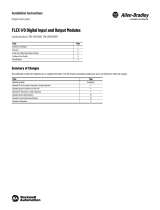Allen-Bradley 1794-IA8I is a FLEX I/O ac Digital Input Module that is designed for use in industrial environments. It can be used to connect up to 8 ac input devices to a PLC or other control system. The module is housed in a rugged enclosure that is designed to withstand harsh conditions. It also has a built-in diagnostic system that can help to identify any problems with the module or the connected devices.
The 1794-IA8I module is easy to install and use. It can be mounted on a DIN rail or in a panel. The module has a variety of features that make it a versatile choice for a wide range of applications. These features include:
Allen-Bradley 1794-IA8I is a FLEX I/O ac Digital Input Module that is designed for use in industrial environments. It can be used to connect up to 8 ac input devices to a PLC or other control system. The module is housed in a rugged enclosure that is designed to withstand harsh conditions. It also has a built-in diagnostic system that can help to identify any problems with the module or the connected devices.
The 1794-IA8I module is easy to install and use. It can be mounted on a DIN rail or in a panel. The module has a variety of features that make it a versatile choice for a wide range of applications. These features include:






-
 1
1
-
 2
2
-
 3
3
-
 4
4
-
 5
5
-
 6
6
Allen-Bradley 1794-IA8I Installation guide
- Type
- Installation guide
Allen-Bradley 1794-IA8I is a FLEX I/O ac Digital Input Module that is designed for use in industrial environments. It can be used to connect up to 8 ac input devices to a PLC or other control system. The module is housed in a rugged enclosure that is designed to withstand harsh conditions. It also has a built-in diagnostic system that can help to identify any problems with the module or the connected devices.
The 1794-IA8I module is easy to install and use. It can be mounted on a DIN rail or in a panel. The module has a variety of features that make it a versatile choice for a wide range of applications. These features include:
Ask a question and I''ll find the answer in the document
Finding information in a document is now easier with AI
Related papers
-
Allen-Bradley 1794-OA8 Installation Instructions Manual
-
Allen-Bradley FLEX XT I/O 1794-IF4IXT Installation Instructions Manual
-
Allen-Bradley FLEX I/O 1794-IP4 User manual
-
Allen-Bradley 1794-OW8 Installation guide
-
Allen-Bradley FLEX 1794-IF2XOF2I Installation Instructions Manual
-
Allen-Bradley FLEX I/O 1794-OB8EP Installation Instructions Manual
-
Allen-Bradley series b Installation Instructions Manual
-
Allen-Bradley 1794-IF4I User manual
-
Allen-Bradley FLEX I/O DeviceNet 1794-ADNK Installation Instructions Manual
-
Allen-Bradley FLEX I/O 1794-ID2 User manual
Other documents
-
 Rockwell Automation Allen-Bradley 1794-IB16D User manual
Rockwell Automation Allen-Bradley 1794-IB16D User manual
-
 Rockwell Automation FLEX 1794-TB2 Installation Instructions Manual
Rockwell Automation FLEX 1794-TB2 Installation Instructions Manual
-
Allen Bradley 1794-PS13 User manual
-
 Allen Bradley Allen-Bradley 1794-IE8 FLEX I-O Input Analog Modules User manual
Allen Bradley Allen-Bradley 1794-IE8 FLEX I-O Input Analog Modules User manual
-
 Rockwell Automation Allen-Bradley 794-IRT8 User manual
Rockwell Automation Allen-Bradley 794-IRT8 User manual
-
 Allen Bradley Allen-Bradley 1794-IB10XOB6 FLEX I/O Digital Input/Output Module User manual
Allen Bradley Allen-Bradley 1794-IB10XOB6 FLEX I/O Digital Input/Output Module User manual
-
 ProSoft Technology 3170-PDP User manual
ProSoft Technology 3170-PDP User manual
-
 Rockwell Automation Allen-Bradley 1794-IJ2 User manual
Rockwell Automation Allen-Bradley 1794-IJ2 User manual
-
 Allen Bradley Allen-Bradley 1794-IV16 FLEX I-O Digital Sourcing Input and Sinking Output Modules User manual
Allen Bradley Allen-Bradley 1794-IV16 FLEX I-O Digital Sourcing Input and Sinking Output Modules User manual
-
 Rockwell Automation 1794-OB16 Installation Instructions Manual
Rockwell Automation 1794-OB16 Installation Instructions Manual














